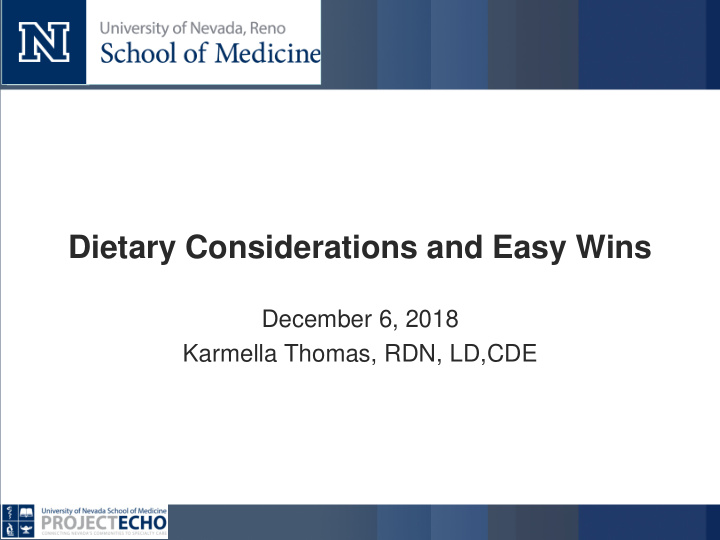



Dietary Considerations and Easy Wins December 6, 2018 Karmella Thomas, RDN, LD,CDE
AAA Case Study – 48 year old male case study… • Type 2 Diabetes (dx 2008; • Peripheral neuropathy family history) • Pancreatitis (binge drinking) – Lantus 65 units BID • Sleep apnea – Humalog 20 units TID (even if • Quit smoking 4 yrs ago no meal) • Weight = 222 pounds – Metformin 1000 mg BID – Jardiance 10 mg/day • BMI = 38.10 • Hemoglobin A1c is 9.3% • Blood Pressure 134/85 last month • Checks BS occasionally • Denies hypoglycemia
Initial MNT assessment • Biggest concern is to lose weight (50 pounds) • High level of stress at home and work • Emotional/binge eating habits • 10 years ago: initially dx, lost 50 pounds, tracked his food, exercised and A1c got down to 6.1% (11% originally) • Not motivated to change for himself – wants to change since his family wants him to change
Nutritional concerns • 24 hour recall = 3,072 calories and 433 grams carbs – McDonalds: 2 cheeseburgers and 32 oz coke – Popcorn at movie theater and 32 oz coke – Two deep fried sushi rolls, water – ½ cup sunflower seeds and water • High consumption of sugar sweetened beverages • Not monitoring blood sugars • Low level of motivation (importance and confidence) • Emotional eating • Burnt out!
Where do we start?
AADE7 Self-Care Behaviors™ 1. Healthy Eating 2. Being Active 3. Monitoring 4. Taking Medication 5. Problem Solving 6. Reducing Risks 7. Healthy Coping
AADE7 Self-Care Behaviors™ 1. Healthy Eating 2. Being Active 3. Monitoring 4. Taking Medication 5. Problem Solving 6. Reducing Risks 7. Healthy Coping
Some considerations • Carbohydrates have the biggest impact on blood sugars – All carbs except for fiber turn into sugar • Eliminate sugar sweetened beverages • Limit snacking – Wait 3 hours between meals and snacks • Watch out for condiments • Record keeping • Keep fat intake at a moderate level • Move daily!
Condiments • Easy to assume these do not impact blood sugars • Most people do not consume 1 TBSP at each meal • Ketchup 1 TBSP = 4.7 g of total carbs – 18grams of carbs for ¼ cup • BBQ Sauce 1 TBSP = 7g of total carbs • Teriyaki Sauce 1 TBSP = 5g of total carbs • Balsamic Vinegar 1 TBSP = 3g of total carbs
Blood Sugar High Carbohydrate Meal - Levels (oatmeal, fruit, toast, juice) Mixed Meal – (pasta with lean meat sauce and veggies) 1 Hour 2 Hours
What should we prioritize first? • What does the patient want to do? – Calorie counting? – Carbohydrate counting? • The total amount of carbohydrate in meals or snacks is more important than the source or type • The more carbohydrates consumed at one time will have a greater impact on post prandial blood sugars Franz MJ. Carbohydrate and diabetes: is the source or the amount of more importance? Curr Diab Rep, 2001;1(2):177-86
2017 Viewpoint in JAMA • Steps to include nutrition counseling during patient appointments: – Start the conversation – 5 A’s – Assess, Advise, Agree, Assist, Arrange – Focus on the small steps – Use available resources – Do not do it all alone • Kahan S, Manson JE. Nutrition Counseling in Clinical PracticeHow Clinicians Can Do Better. JAMA. 2017;318(12):1101–1102. doi:10.1001/jama.2017.10434
Mindful eating • Barriers: – Fast paced world and multitasking – Technology (tv, computers, smart phones) – Guilt associated with eating “bad” foods • Tools: – Hershey’s Kiss exercise – Eat at the dinner table only – Aim for 20 minutes to eat a meal – Smaller utensils
Keep fat at a moderate level • High intake of fat at a meal slows down digestion • Rapid acting insulin may peak before blood sugars increase • Risk is hypoglycemia soon after eating and a much later rise in blood sugar after meal (few hours later) • Fat has the most calories per gram = weight gain = insulin resistance
THANK YOU!
Recommend
More recommend